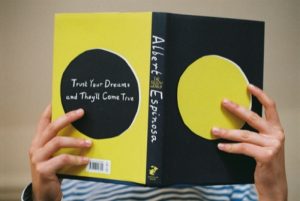‘It’s not a philosophy, it’s not a religion; it’s just lessons learned from cancer.’*

*Espinosa on his ideas in general, and his concept of ‘Yellows’ in particular, p.173.
Espinosa survived childhood cancer, spending a lot of time between the ages of 14-24 in hospital, losing a lung, a leg, and more – including many fellow patients, or ‘eggheads’, as he calls them (from the baldness caused by chemo’) – to the disease. This book is one of the things to come out of his experience.
Surviving cancer is a great/amazing and, thankfully, ever more common thing. And not to be sniffed at. However, as a generator of self-help literature it has, in my limited experience, a chequered past. I was once gifted a book by Louise Hay, who survived cervical cancer, which shared the positivity aspect that is the chief strength of this book, but then went seriously bonkers in ‘diagnosing’ the supposed causes of disease.

Fortunately Espinosa seems more rationally tethered to reality than Hay. Although that said, whilst I like many aspects of it, I don’t buy fully into either his core ‘yellow’ idea, or even less so his (to me) arbitrary choice of 23 ‘yellows’ in your life. His concept of a ‘yellow’ is essentially someone more than a friend but less than (or different to) a lover. If you’re keen to understand his ideas, read the book. I’m not going to synopsise them any further here.
Chapters are on the whole plentiful but very short, which, together with the informal writing style, make this is an easy if rather whimsical read. It’s certainly more poetic and thoughtful than scientific or intellectual. Like me, the author likes lists. But, and again like me, despite his penchant for lists the overall feel of the book is somewhat loose and random feeling. One little unexpected nugget; I like that there’s a very positive and somewhat surprising chapter on ‘wanking’!
For those affected by cancer, whether personally or indirectly (and in many ways most of us are), this may well be worth a read. Beyond that rather particular aspect, the primary and more general thing I take from this book is that it’s best to reframe potentially negative events in as positive a light as one can. A stunningly obvious ‘lesson’, in all honesty. But nevertheless one a great many of us find hard to put into practice.
Three stars seems mean, and four stars generous, for so slight and whimsical a book. So I’ll give it three and a half.

* Here’s a link to an article on the design of this book-cover: https://www.designweek.co.uk/issues/may-2012/book-designer-jon-gray-on-creating-the-yellow-world/
